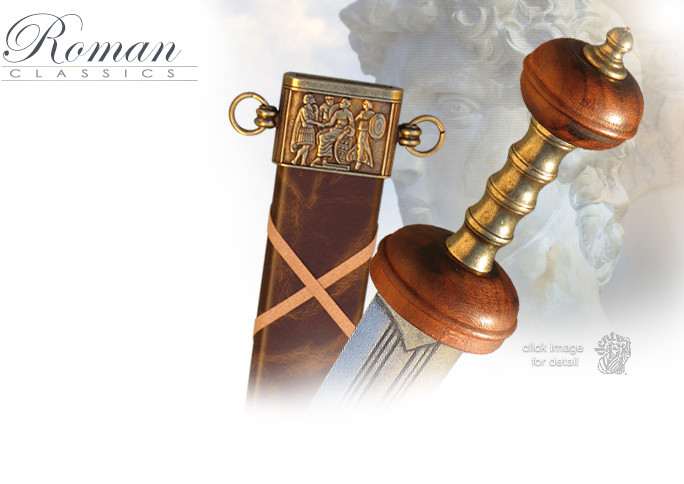ROMAN GLADIATOR SWORD  4140 by DENIX 4140 by DENIX
The Coliseum comes to life in the realism and detail found in this massive short sword replica by Denix of Toledo Spain. This beautifully detailed Roman Gladiator decorator sword features 20 1/4" cast metal blade that is 2.5" wide at the hilt and carries a distinctive blood groove. The hand guard and pommel are of turned hardwood and are beautifully accented by a cast metal grip and pommel button finished in antique brass. Comes with a matching wood scabbard wrapped in simulated leather and straps with antiqued brass engraved furniture. The blades of Denix daggers and swords are cast from a metal alloy and cannot be sharpened, making them safe for display in family environments. As an additional benefit of cast alloy material, the blade loudly produces the "classic ring sound" when quickly drawn from its scabbard making this a perfect choice for film, live theatre stage, as well as decorative display.
Read more on Decorative Series Swords
|
|

• Overall Length: 27 1/2"
• Blade Length: 20 1/4"
• Handle Length: 7 1/8"
• Blade Edge: unsharpened
• Blade Material: Zinc Alloy
• Blade Width at Guard: 2 1/2"
• Hilt: Wood /Sim Cast Brass Alloy
• Scabbard: Wood/sim leather/Zinc Fittings
• Sword Weight: 4 lbs 5 oz

Specs may vary slightly from piece to piece.
|
Who were the Gladiators?
In general, gladiators were prisoners of war,condemned criminals, or slaves bought for the purpose of gladiatorial combat by a lanista, or owner of gladiators. Professional gladiators were free men who volunteered to participate in the games. In The Satyricon, Petronius suggested that Roman crowds preferred combat by free men over that of slaves. For example, the character of Echion is excited about games in which free men, "not a slave in the batch," will fight. Though low on the social scale, free men often found popularity and patronage of wealthy Roman citizens by becoming gladiators. The emperor Augustus sought to preserve the pietas and virtus of the knight class and Roman senate by forbidding them to participate in gladiatorial combat. Later, Caligula and Nero would order both groups to participate in the games. Though a gladiator was only required to fight two or three times a year, few survived the three to five years.
|